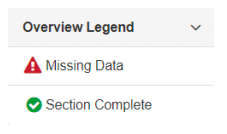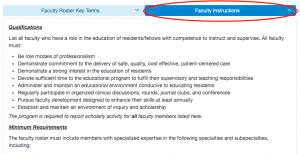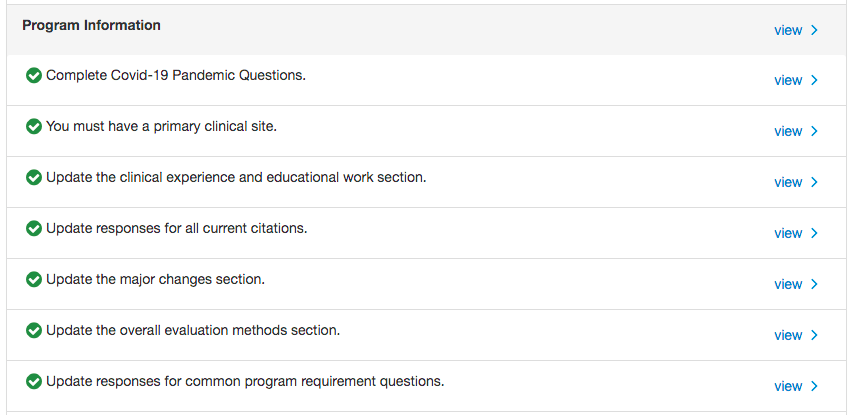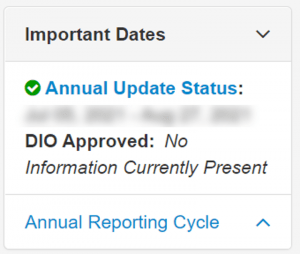Accreditation Data System (ADS) Update
All ACGME-accredited programs must submit an Annual Update through the Accreditation Data System (ADS) by their assigned ACGME deadline. While ADS can be updated throughout the year, the official Annual Update is a key component of the ACGME’s program oversight.
Per Institutional Requirements (1.2.c.), the DIO is responsible for overseeing the submission of all ADS Annual Updates. To allow adequate time for institutional review, programs must submit their Annual Update to the DIO approximately three weeks before their ACGME-assigned deadline.
See the “Finalizing and Submitting Your ADS Update to the DIO” section below for additional guidance.
2025-2026 Deadlines
| ACGME Due Date | Submit to DIO by |
|---|---|
| August 22, 2025 | August 4, 2025 |
| September 19, 2025 | September 2, 2025 |
September Programs: Deadline moved to September 2, 2025 to account for the holiday.
Not sure of your program’s assigned date?
Check the ACGME’s 2025–2026 ADS Annual Update Schedule by Specialty.
Please review the GME and ACGME resources below carefully. Data submitted in the ADS Annual Update often informs citations and areas for improvement.
Program Directors: You are ultimately responsible for the information provided in your ADS annual update and should review all information prior to final submission.
GME Presentations
- ADS Annual Update Lunch & Learn
ACGME Resources
- Avoiding Common Errors in the ADS Annual Update – includes detailed information on responding to citations, entering scholarly activity and creating an effective block diagram.
- Program Directors’ Guide to the Common Program Requirements
- Annual Update Changes 2025-2026
- Annual Update FAQs 2025-2026
How to:
Accessing the Accreditation Data System (ADS) and the Annual Update.
Instructions and Navigation
| Log in to ADS Go to https://login.acgmecloud.org and use your ACGME Cloud credentials (email, password, and multi-factor authentication) to access ADS. If you haven’t set up your ACGME Cloud account yet, follow the instructions here: How to Set Up ACGME Cloud and Multi-Factor Authentication |
|
|
Navigate to Overview Tab. Note: At the top of the far right Reference Panel is the due date for your program. Reminder – programs must submit to the DIO three weeks prior to the assigned ACGME due date in order to allow for review. |
Click to enlarge |
|
For the Annual Update you have to make sure to complete all required sections. Note: Even if your ADS update section is marked “Section Complete” you must review and make sure the information is up-to-date. Complete all the missing information and then review all parts. |
Click to enlarge |
Tips for completing your ADS Update
If your program is under initial accreditation, your ADS Update format and questions may differ slightly.
Remember, the ACGME reviewers who read your ADS Update are not familiar with your program or our system. Make sure to spell out acronyms and explain site or system specific oddities.
Note: Even if your ADS update section is marked “Section Complete” you must review and make sure the information is up-to-date.
Program Information
Specialties who are required to report case logs will have additional questions.
| ADS Question | Tips |
| Effects of the Pandemic on the Program | |
1. For each item, please indicate the overall effect of the pandemic over the past academic year, compared to normal, pre-pandemic levels prior to March 2020, on each of these activities for your residents or fellows:
|
Please answer as appropriate for your program. Answers should reflect the past academic year (July 1, 2020 – June 30, 2021). |
2. For each item, please indicate the overall effect of the pandemic over the past academic year, compared to normal, pre-pandemic levels prior to March 2020, on each of these activities for your faculty:
|
Please answer as appropriate for your program. Answers should reflect the past academic year (July 1, 2020 – June 30, 2021). |
| 3. During the past academic year, did you use a “platooning” system in your program due to the COVID-19 pandemic? |
Please answer as appropriate for your program. Answers should reflect the past academic year (July 1, 2020 – June 30, 2021). |
4. Regarding the use of telemedicine during the past academic year:
|
Please answer as appropriate for your program. Estimates suffice. Answers should reflect the past academic year (July 1, 2020 – June 30, 2021). |
| 5. For each category of impact below, how many months of the past academic year would you estimate the pandemic had a negative impact on the education the residents or fellows in your program? (answers should add up to 12): |
Please answer as appropriate for your program, make sure that your answers add up to 12 months. Answers should reflect the past academic year (July 1, 2020 – June 30, 2021). |
6. Were any residents or fellows required to extend their training for any reason related to the pandemic? (If no, skip questions 6a and 6b)
|
Please answer as appropriate for your program. Answers should reflect the past academic year (July 1, 2020 – June 30, 2021). |
| 7. Were elective surgeries and/or procedures in your (sub)specialty postponed or cancelled at your program’s primary or participating sites at any time during the past academic year due to the pandemic? |
Please provide information related to elective operations and/or procedures in your specialty/subspecialty. Answers should reflect the past academic year (July 1, 2020 – June 30, 2021). |
8. Please respond to the following questions about the elective surgeries/procedures that residents or fellows in your program normally take part in:
|
Please answer as appropriate for your program. Answers should reflect the past academic year (July 1, 2020 – June 30, 2021). Note: 8b only applies to specialties/subspecialties with case logs. |
| Health Effects of the Pandemic | |
9. The responses to the following items should reflect what occurred in your program during the past academic year (between July 1, 2020 and June 30, 2021).
|
Vaccination rates for UW Medicine staff as a whole can be used if your program-specific information is not known. (UW rates coming soon) If exact numbers are not known, please estimate. Note that question 9 answers are not are shared with Review Committees or used in accreditation decisions. Answer for the past academic year (July 1, 2020 – June 30, 2021). |
Primary Clinical Site
Each program must designate one Primary Clinical Site, which is defined as the facility most commonly used for clinical training in the program. This designation determines the Primary Site Visit Location for the program.
To designate or update the Primary Clinical Site:
- Click “Edit” to access the Participating Sites section.
- For the site that serves as your Primary Clinical Site, select “Yes” under the “Primary Clinical Site” field.
- For all other sites, select “No.”
Only one site should be marked as the Primary Clinical Site.
Clinical Experience and Educational Work
This section is only applicable to programs with Initial Accreditation.
| ADS QUESTION | TIPS |
| 1 – 3 | Please answer as appropriate for your program |
| 4. Indicate the ways your program educates residents/fellows and faculty members to recognize the signs of fatigue and sleep deprivation, alertness management and fatigue mitigation processes. | Please answer “Computer based learning modules” in addition to anything else appropriate for your program. Trainees complete an eLearning module related to fatigue. |
Citations (if applicable)
Use this space to give a thorough response to new or continued citations. See ACGME’s Avoiding Common Errors in the ADS Annual Update and review the “Responding to Citations Video”.
- If you haven’t yet addressed the citation, then describe what you plan to do. Be specific and thorough. Include dates, who is responsible, etc.
- If you are addressing an extended citation then be sure to update your previous answer. The information previously provided was not enough to show adequate compliance with the citation. How have you continued to address the citation and what do you plan to do moving forward?
- If goals are not met, explain why and outline next steps.
- Showcase any verifiable outcomes such as improved survey results, etc.
- If you feel that you received a citation that is unwarranted, then clearly explain the situation and why you feel it is unwarranted.
Please reach out to UW GME for assistance if needed.
Major Changes and Other Updates
| ADS QUESTION | TIPS |
| Provide a brief update explaining any major changes and other updates to the educational program in the last academic year, e.g., changes to program leadership and the faculty, rotational changes, curricular innovations, program challenges, efforts to address issues identified in the annual ACGME Surveys, and the impact of disruptions on resident/fellow education. |
This section is your opportunity to speak directly to the ACGME. Use the full word count to provide a comprehensive update on your program. Be sure to address the following, where applicable:
|
Overall Evaluation Methods
This section is only applicable to programs with Initial Accreditation.
| ADS QUESTION | TIP |
| 1 | Answer as appropriate for your program |
| List the members of the Clinical Competency Committee | Please list the names of all CCC members and at a minimum meet requirement CPR 5.3.a.): At a minimum, the Clinical Competency Committee must include three members of the program faculty, at least one of whom is a core faculty member. |
| List the members of the Program Evaluation Committee | Please list the names of all PEC members and at a minimum meet requirement CPR 5.5.a.): The Program Evaluation Committee must be composed of at least two program faculty members, at least one of whom is a core faculty member, and at least one resident. |
| Does the program director or a program director designee meet and review with all residents/fellows their individual documented evaluation of performance, including progress along the specialty- or subspecialty-specific Milestones, on a semi-annual basis? |
Please answer yes per requirement CPR 5.1.c. The program director or their designee, with input from the Clinical Competency Committee, must: meet with and review with each resident their documented semi-annual evaluation of performance, including progress along the specialty-specific Milestones; (Core) |
Program Resources and Curriculum
|
ADS QUESTION |
TIPS |
|
Program Resources |
|
|
What percent of FTE support is allocated to the program director for non-clinical time devoted to the administration of this program? |
Be sure to list as a percentage. If PD FTE does not meet or exceed requirements, you are at risk of a citation. Please refer to your specialty-specific requirements. |
|
In aggregate, what percent of FTE support is allocated to the associate program director(s) for non-clinical time devoted to the administration of the program? If not applicable, enter “0” in the response.
|
Be sure to list as a percentage. If APD FTE does not meet or exceed requirements, you are at risk of a citation. Please refer to your specialty-specific requirements. |
| If you have more than one associate program director, use the text box below to further explain. |
Please answer as appropriate for your program |
| In aggregate, what percent of FTE support is allocated to the program coordinator(s) for time devoted to the administration of this program? |
Be sure to list as a percentage. Review committees specify required PC FTE, please refer to your specialty-specific requirements. If PC FTE does not meet or exceed requirements, you are at risk of a citation. If your PA/PC supports multiple programs be sure to list only the FTE devoted to this specific program. If multiple PAs/PCs support your program then combine all of their FTE and include it here. |
|
(Question only applicable for programs whose Review Committees have established requirements) In aggregate, what percent of FTE support is allocated to core faculty members for time dedicated to educational and administrative responsibilities that do not involve direct patient care? |
Be sure to list as a percentage. To calculate, combine all of the dedicated FTE for your core faculty. If Faculty FTE does not meet or exceed requirements, you are at risk of a citation. Please refer to your specialty-specific requirements. |
|
Questions for Programs with Initial Accreditation only |
Please answer yes – Trainees have access to resources for self-screening, located on the Wellness webpage. |
|
|
Please answer yes – trainees have access to GME Wellness Counselors and urgent and emergent care. |
|
Resident/Fellow Education and Experience |
|
| (Question only applicable to programs with Initial Accreditation) How are/will residents/fellows and faculty members be informed about their assignments, the responsibilities expected of each rotation, and the goals and objectives for each assignment? Check all the apply. | Please answer as appropriate for your program |
| What other learners/other health care personnel will be/are sharing educational or clinical experiences with the program’s residents/fellows? Check all that apply. | Please answer as appropriate for your program |
|
(Question only applicable to programs with Initial Accreditation) Describe the process for residents/fellows to report problems and concerns at the program and Sponsoring Institution levels. The answer must include how the process ensures resident/fellow confidentiality, minimizes fear, investigates concerns, and, when appropriate, addresses such concerns. |
Please include the following potential avenues:
|
| Indicate what residents/fellows will be/are taught about pain management, including the recognition of the signs of substance-use disorder (SUD). Check all that apply. | Please answer as appropriate for your program. |
|
Faculty Development |
|
|
In which areas have program faculty members participated in faculty development over the past year? (Question only applicable to programs with Initial Accreditation) |
Please answer as appropriate for your program. Of note, bi-annual Educator Development for GME Excellence Series (EDGE) events are designed to provide rotating training on these topics. |
|
Check all domains in which your faculty members demonstrated accomplishments in scholarly activity in the past academic year:
|
Please make sure that at least three domains are covered by the faculty as a group. See CPR 4.14.: Among their scholarly activity, programs must demonstrate accomplishments in at least three of the following domains. |
|
Check all methods used to disseminate faculty scholarly activity within and external to the program in the past academic year: |
Please make sure to select all relevant domains covered by the faculty as a group. See CPR 4.14.a.: The program must demonstrate dissemination of scholarly activity within and external to the program by the following methods. |
Program Profile
| ADS Question | Tips |
| Program Information |
|
| Please answer as appropriate to your program. | |
| Accreditation Information | |
| Please answer as appropriate to your program. | |
| Mission and Aims | |
| Provide the program’s mission statement. | See UW Medicine’s Mission & Vision. |
| (Question only for programs under Initial Accreditation) Provide four to six aims that the program uses to achieve its mission. |
Aims describe specific program efforts to achieve the mission. Examples: Residents spend at least six months in community-based rotations, primary site is a research-rich environment with many opportunities for fellow involvement, and program offers a range of options for faculty development and monitors faculty member participation. Resource: Improvement in Context: Exploring Aims, Improvement Priorities, and Environmental Considerations in a National Sample of Programs Using “Small Data” (Philibert, et al., JGME, 2017) |
Participating Sites Tab
Programs must update the Sites section and enter all participating sites that routinely provide an educational experience, required for all residents/fellows, of one month or more. Refer to the specialty-specific program requirements for further specification.
List all participating sites that are physically located at different locations (e.g., two separate outpatient clinics within the same health system should be listed as two separate participating sites). However, if residents/fellows travel with a faculty member from a hospital to an outpatient clinical location on the same campus or within 30 minutes road travel time, the location should be considered part of the hospital participating site.
Programs should regularly review their list of participating sites and make updates in ADS as needed to ensure accuracy. The order and names of sites listed should be consistent in both ADS and the program’s block diagram. Be sure to review instructions in ADS and on the ACGME website to confirm that the block diagram uses the Review Committee-required template, if applicable. If you are unsure, or need to add or remove a site, please contact plas@uw.edu for guidance.
To update information for all sites, click “Edit” next to site name.
|
ADS QUESTION |
TIPS |
| Is this a site for patient care? |
Please answer as appropriate for the site. |
| Primary Clinical Site |
See primary clinical site section above for instructions. |
|
Required Rotation Do all residents rotate through this site |
Please answer as appropriate for the site, but please note, if at least some residents/fellows have required experiences at a participating site, please select “required rotation = yes.” If a participating site is used for only some residents/fellows, indicate “do all residents rotate through this site = no.” |
|
Program Letter of Agreement (PLA) exists between program and site |
Please answer as appropriate for the site. For the following sites, please select “N/A (site under governance of sponsoring institution).” See PLA page for more details.
|
| Program Letter of Agreement (PLA) Date |
If the answer to previous question “Program Letter of Agreement (PLA) exists between program and site?” is “Yes”, please be sure to list or update the effective date of the agreement. Please see instructions for viewing your active PLAs in MedHub (see “Viewing Active PLAs in MedHub”). If your PLA effective date is more than 5 years old, the agreement will need to be updated. See the process for renewing a PLA. |
| Rotation Months |
Please provide an accurate amount of time trainees spend at each site. Entries may be whole numbers or decimals (i.e. to reflect half of a month, enter 0.5). If the total number of rotation months per year does not equate to 12 months for all sites combined, please provide an explanation in the comments section on the Sites tab. If your program has multiple tracks with different sites, please consult UW GME for guidance. Please make sure the number of rotation months at each site aligns with your block diagram (see instructions in the block diagram section). |
| Distance to Primary Clinical Site |
Please answer as appropriate for the site. |
|
Briefly describe the content of the educational experience (addressing faculty coverage, volume/variety of clinical experience, site support and educational impact) |
Please cover the reasons that your program includes this educational site. Information should be specific to this site, and should not repeat information found elsewhere (i.e. block diagram). |
| Site Director |
Update as appropriate. Please see instructions for viewing your active PLAs in MedHub (see “Viewing Active PLAs in MedHub”). |
|
|
For UWMC-ML, UWMC-NW, HMC, SCH and the VA please select: Safe, quiet, clean, and private sleep/rest facilities available and accessible with proximity appropriate for safe patient care
For all other sites please look into available resources. Note that Common Program Requirements state that trainees must have access to food while on duty (1.9.a.); rest facilities (1.9.b.); lactation facilities (1.9.c.); security and safety measures (1.9.d); and disability accommodations (1.9.e.). For UW sites, please see Lactation Stations and look listings of refrigeration (click on “Map” for more information). Note: The ACGME has confirmed that a cooler meets the requirements for refrigeration. The GME Office has a number of coolers available to loan, if needed. |
|
Comments |
Please include any additional information that will help the review committee understand your educational experiences. |
Block Diagram
Programs must update their Block Diagram (see below) with all required experiences of 1+ months. If you have a missing site, please contact plas@uw.edu.
To update information for all sites, click “Edit” next to site name.
- How to Create an Effective Block Rotation Schedule. This brief video explains the purpose of a Block Rotation Schedule and highlights commonly made mistakes.
- Download ADS Block Rotation instructions listed in ADS. Some specialties may have Specialty Instructions, please see the Block Diagram section in the Site’s tab, or the Documents and Resources section for your specialty.
- Make sure to include a header with your program name and ACGME number!
- Vacation time provided should be listed either in the Notes section or in a block. Please also include a note with specifications around taking vacation time (i.e. vacation not allowed on Block 3, etc.). Please ensure to account for 28 days of vacation per the CBA.
- Remember, the block diagram should:
- Show that you are meeting your specialty-specific curricular requirements (CPR 4.10).
- Be a clear representation of your rotation schedule.
- Correspond with the rotation months that are listed in ADS in the Sites tab.
Resident/Fellow Information
At the start of each academic year, programs must review and update their Resident/Fellow Roster. This includes adding any new residents/fellows for the current academic year, promoting trainees to the next level, graduating those who have completed training, and making any other necessary updates.
See “View Roster” tab below for detailed instructions on Resident Profiles.
Note: For programs in which residents are required to record Case Logs in ADS, ensure that new residents receive their ADS log-in information.
View Roster
If you have more trainees than your complement allows please reach out to hadars@uw.edu
| ADS QUESTION | TIPS |
| Resident Information |
For new residents, fill in all resident/fellow data. If they have been in a previous ACGME program, click the “Verify Resident” button to find their previous profile. National Provider ID – If a resident/fellow does not have an NPI number, please wait to add them to the roster until received.* Social Security Number – If a resident/fellow does not have a SSN, please wait to add them to the roster until received.* *If the NPI or SSN will not available by your Annual Update deadline, please contact webADS@acgme.org prior to your deadline to request temporary placement codes. |
| Resident Status | Select the appropriate status, make sure to update for any trainees who have graduated or left the program. |
|
Resident Details |
Please fill in all resident/fellow data. For continuing residents/fellows, make sure to update their year in program. If there are any extensions of trainings, make sure to update expected completion date. |
|
Comments |
For continuing residents/fellows, if there was an extension of training please address in the comments. |
|
Username |
For new trainees who have to do case log entry the ADS system will generate a username and alert trainee by email. Please be sure to alert your trainees that this email is coming. |
Scholarly Activity
To gather resident information it is recommended that you survey residents/fellows for their most up-to-date data. See example from Radiation Oncology for gathering resident/fellow data.
Refer to your specialty-specific requirements for Resident Scholarly Activity requirements (CPR 4.15.).
Click “Edit” to update individual residents / fellows.
| ADS QUESTION | TIPS |
| Edit Scholarly Info | Follow instructions when listing Pub Med IDs, other publications, conferences presentations, chapters or textbooks and participation that occurred during the previous academic year. |
Certification
Faculty Information
Add Faculty
View Roster
Instructions on who to include in faculty roster are specialty-specific. Program Directors must review their specialty-specific requirements, and may add or remove faculty members at their discretion to ensure requirements are met.
Note: In subspecialty programs, all faculty members will be scheduled to receive the annual ACGME survey. In specialty programs only Core Faculty will receive the survey. It is important to ensure that faculty listed on the roster are familiar with the program.
Please make sure that the faculty listed meet all outlined requirements for your specialty.
Case log faculty do not need to be included in the roster.
|
All faculty member’s profiles must be reviewed and edited. To edit, hover over individual’s name and click “Edit” button. In addition, for Program Directors, please also edit the CV. To edit, hover over PD’s name and click “Edit CV” button. |
|
| ADS QUESTION | TIPS |
| Faculty Profile |
|
| General Information |
Program Specific Title – Please update appropriately for all faculty members. NPI Number – Accurate NPI numbers allow for the automatic importation of faculty certification data (see Specialty Certification section below). Please verify the numbers for all faculty members. If a faculty member’s number is missing or unknown, use the “Search National Provider ID” link provided in ADS to find it.
Is this faculty member core? –
|
| Medical School | Please answer as appropriate for each faculty member. |
|
Specialty Certification |
ACGME automatically imports faculty certification data from the American Board of Medical Specialties (ABMS) and American Osteopathic Association (AOA). For any newly entered or updated faculty or faculty NPI numbers, please allow 24 hours for data to import. If after this time the data is still missing or inaccurate, and faculty member’s name and NPI number have been verified, please manually enter certification data into ADS. To manually enter certification, click on “Specialty Certification – Manual Entries”:
|
|
Area of Specialization (for non-physician faculty) |
A manual entry option is available and should be used to enter any certifications for non-physician faculty members. Under Area of Specialization, click “+Add” button to input missing data, including: area of specialization, name of certifying body, name of certificate, year of original certification, certification status, and specialization/certification clarification text box. Please note: missing data icon will appear for all US Non-physicians. |
|
Case Log Attending (if applicable) |
Please answer as appropriate for each faculty member. |
|
It’s very important to ensure that the PD’s profile and CV have been updated per instructions. |
|
|
Program Director’s CV |
Graduate Medical Education – please edit as appropriate. Licensures – please edit as appropriate. Ensure that the expiration date is in the future. Academic Appointments – please edit as appropriate, do not exceed the last ten years. Concise Summary of Role/Responsibilities in Program – please update as appropriate. Make sure the current role in the program is mentioned. Current Professional Activities / Committees – please update as appropriate, do not exceed last five years or more than ten items. Bibliographies – please update as appropriate, do not exceed last five years or list more than ten items. All items listed should be from peer-reviewed publications. Do not include accepted articles that have not yet been published. Articles – please update as appropriate. Include review articles, chapters and/or textbooks. Do not exceed last five years or list more than ten items. Do not include accepted articles that have not yet been published. Participation in Local, Regional and National Activities / Presentations / Abstracts / Grants – please update as appropriate. Do not exceed last five years or list more than ten items. You may include scheduled activities that were canceled due to COVID-19. |
Manage Core Faculty
Instructions on who to include in faculty roster are specialty-specific. Program Directors must review their specialty-specific requirements, and may add or remove faculty members at their discretion to ensure requirements are met.
Note: In subspecialty programs, all faculty members will be scheduled to receive the annual ACGME survey. In specialty programs only Core Faculty will receive the survey. It is important to ensure that faculty listed on the roster are familiar with the program.
To review requirements, on the “View Roster” tab click “Faculty Instructions”.
Finalizing and Submitting your ADS Update to the DIO
Per ACGME’s Institutional Requirements the DIO must oversee the submission of all ADS Annual Updates (1.2.c).
To allow adequate time for GME review and approval, programs will need to submit their annual updates ~3 weeks in advance of their ACGME deadline. Find your program-specific ACGME due date in ADS, in the top-right corner when on the Program Overview tab.
Upon submitting the Annual Update, ADS will trigger a message for the designated institutional official (DIO) or institutional coordinator to approve the update. GME can approve or return the update to program for edits. If returned, program must resubmit Annual Update in advance of ACGME assigned due date. If further updates are made later in the academic year, ADS will not trigger another message for DIO approval.
Instructions
|
After updating all ADS items: 1) Review your information Click on the “Overview” tab and then click “Complete” to expand the Annual Update section to see current status of all the various parts of the Annual Update. All items should be double checked before submitting.
|
Click to enlarge Click to enlarge |
|
2) Submit your ADS update to the DIO by clicking ‘Submit’. On behalf of the DIO, the GME Office will review your annual update and contact you if we have issues or recommended edits. To check the status of DIO Approval in the top right corner of ADS. Prior to submission a red triangle icon will be visible, after submission to a DIO a green circle with checkmark will show. |
Click to enlarge.
Click to enlarge. |
|
3) If contacted with recommended edits, update relevant sections and resubmit the ADS Annual Update. Make recommended edits and resubmit ADS Annual Update. Note, the program-specific ACGME Annual Update deadline must be met. |
Click to enlarge. |
|
3) Save the final version to your files. Go to the summary page, click “Print” and then save as a PDF. |
Click to enlarge |

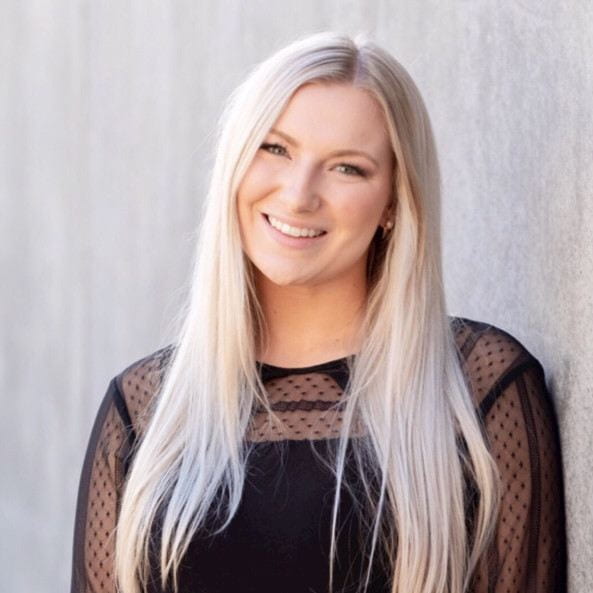

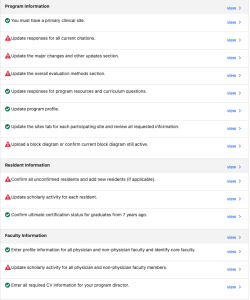 Click to enlarge
Click to enlarge